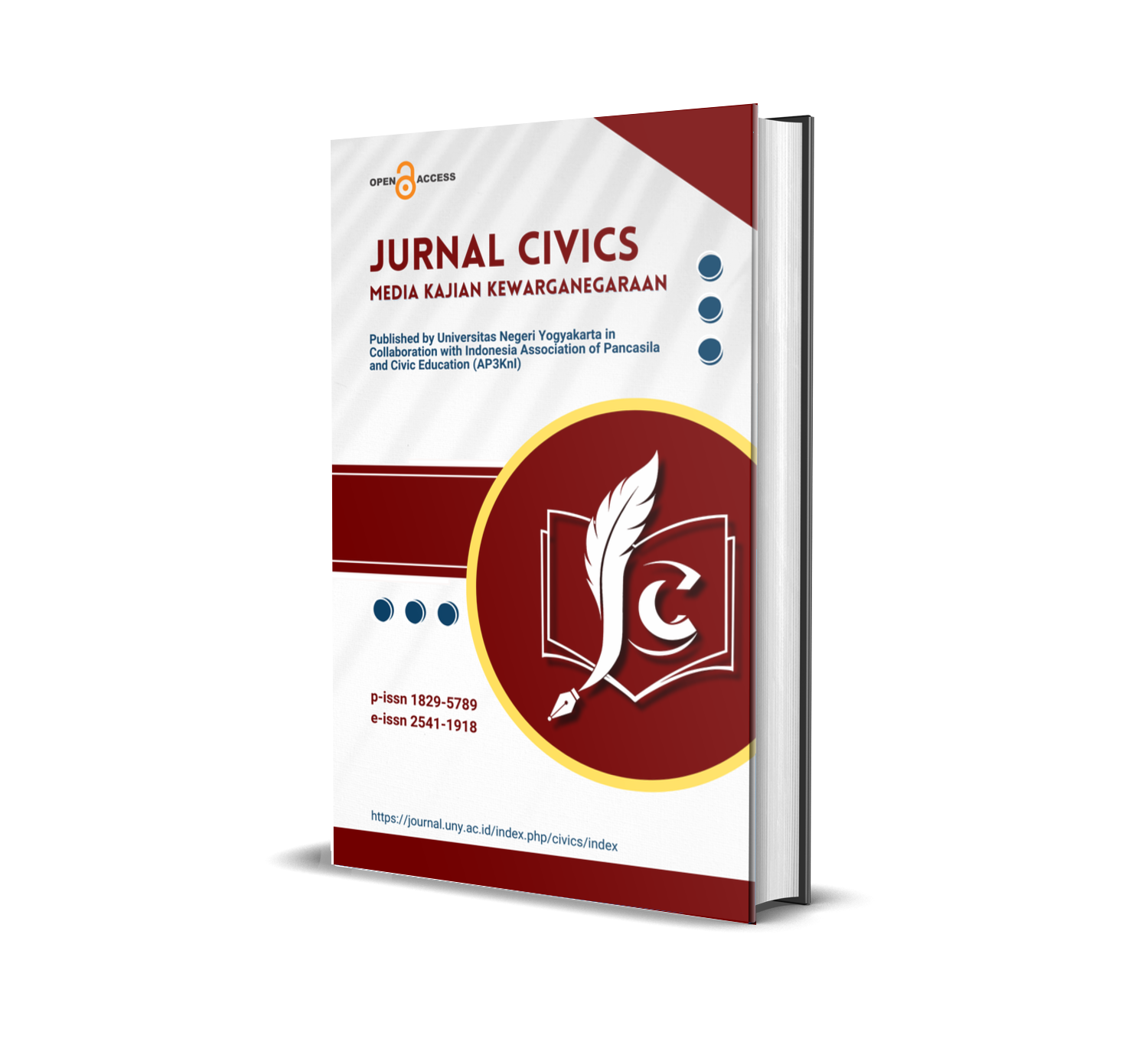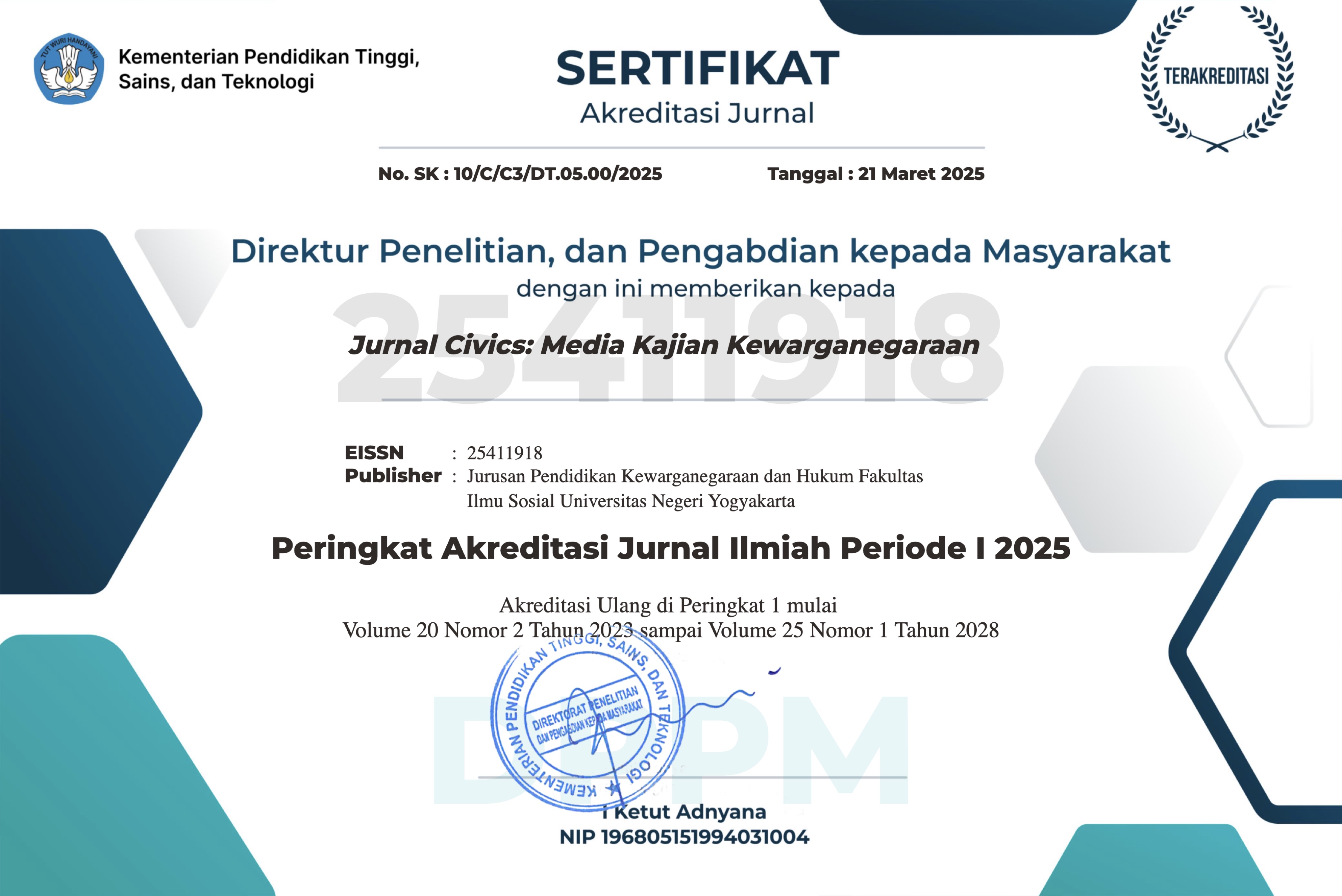Persepsi mahasiswa terhadap kemunculan berita bohong di media sosial
DOI:
https://doi.org/10.21831/jc.v15i1.17296Keywords:
hoax, civic literacy, social mediaAbstract
Di era demokratisasi saat ini yang bercirikan adanya kebebasan berpendapat setiap warga baik secara lisan ataupun tertulis, maka fenomena hoax menjadi satu hal yang harus menjadi perhatian bersama. Desain penelitian yang digunakan adalah penelitian survey. Proses penyebaran berita dalam media sosial banyak melibatkan kaum perempuan. Hanya sebagian kecil saja yang mengakui sering mendapatkan berita-berita hoax tentang suku, agama, ras, dan antar golongan (SARA). Dengan demikian, maraknya penyebaran berita hoax di media sosial merupakan satu bentuk pembodohan masyarakat dan respons terhadap kemunculan berita hoax dengan cara melakukan tindakan perlawanan.
-----------------------------------------------------------------------------------------------------------------------------
In this democratization era characterized by the freedom of speech belongs to every citizen both written and spoken, the hoax should be considered seriously. It was a survey research. The spread of news through social media was conducted mostly by women. It was only small numbers who reported that they had received hoax relating SARA. Therefore, the spreading of hoax through social media is a kind of fooling and their response is through counter-narrative.
References
Aribowo, E. K. (2017). Menelusuri jejak hoaks dari kacamata bahasa: Bagaimana mendeteksi berita palsu sedini mungkin. In Literasi dalam Pembelajaran Bahasa (hal. 78–87).
Arikunto, S. (2013). Prosedur penelitian. Suatu pendekatan praktek (15 ed.). Jakarta: Rineka Cipta.
Arpannudin, I. (2016). Literasi warga negara muda untuk pengembangan civic engagement di abad 21. In Sapriya, Syaifullah, S. Fitriasari, L. Anggraeni, D. Iswandi, D. I. Muthaqin, ... R. Yudistira (Ed.), Prosiding Seminar Pendidikan Kewarganegaraan sebagai Bidang Ilmu dan Program Pendidikan dalam Konteks Penguatan Daya Saing Lulusan. Bandung: Labratorium Pendidikan Kewarganegaraan Universitas Pendidikan Indonesia.
Banks, J. A. (2008). Diversity, group identity, and citizenship education in a global age. Educational Research, 37(3), 129–139.
Bennett, W. L. (2008). Changing citizenship in the digital age. In W. L. Bennett (Ed.), Civic life online: Learning how digital media can engage youth (Vol. , hal. 1–24). Cambridge: The MIT Press. https://doi.org/10.1162/dmal.9780262524827.001
Cohen-Almagor, R. (2010). Responsibility of and Trust in ISPs. Knowledge, Technology & Policy, 23(3–4), 381–397. https://doi.org/10.1007/s12130-010-9119-3
Common Sense Media. (2009). Digital literacy and citizenship in the 21st century. San Francisco: Common Sense Media.
Hallikainen, P. (2015). Why people use social media platforms: Exploring the motivations and consequences of use. In L. Mola, F. Pennalrola, & S. Za (Ed.), From information to smart society enviroment, politics, and economics (hal. 9–17). Switzerland: Springer International Publishing. https://doi.org/10.1007/978-3-319-09450-2
Haryanto, I. (2017). Imbangi hoaks dengan tradisi baca. Diambil 28 Mei 2018, dari https://kompas.id/baca/opini/2017/09/14/imbangi-hoaks-dengan-tradisi-baca/
IFLA. (2018). Mengenali informasi palsu. https://www.ifla.org/publications/node/11174. Diambil dari https://www.ifla.org/files/assets/hq/topics/info-society/images/indonesian_-_how_to_spot_fake_news.pdf
Juliswara, V. (2017). Mengembangkan model literasi media yang berkebhinekaan dalam menganalisis informasi berita palsu (hoax) di media sosial. Jurnal Pemikiran Sosiologi, 4(2), 142–164. https://doi.org/https://doi.org/10.22146/jps.v4i2.28586
Kahne, J. ., & Middaugh, E. (2012). Digital media shapes youth participation in politics. Phi Delta Kappan, 94(3), 52–56. https://doi.org/10.1177/003172171209400312
Kemp, S. (2018). Digital in 2018. Essential insights of internet, social media, mobile, and ecomemmerce use around the world. We Are Social.
Martens, H., & Hobbs, R. (2015). How media literacy supports civic engagement in a digital age. Atlantic Journal of Communication, 23(2), 120–137. https://doi.org/10.1080/15456870.2014.961636
McGonagle, T. (2011). Media literacy : No longer the shrinking violet of European audiovisual media regulation? In Media Law and Policy (hal. 187–212).
Milner, H. (2002). Civic literacy: How informed citizens make democracy work. Hanover, NH: University Press of New England.
Mossberger, K., Tolbert, C. J., & McNeal, R. S. (2008). Digital citizenship. The internet, society, and participation. Cambridge, Massachusetts London, England: The MIT Press.
Muhammad, G. (2017). Universitas dan pasca kebenaran. Surakarta: Universitas Sebelas Maret.
Noonan, C., & Platt, A. (2015). Global social media directory". Pacific Northwest National Laboratory. Washington. Diambil dari http://www.pnnl.gov/main/publications/external/technical_reports/PNNL-23805rev1.pdf
Potter, W. J. (2009). Media literacy. In W. F. Eadie (Ed.), 21st Century Communication: A Reference Handbook (hal. 558–570). London; California; New Delhi; Singapore: Sage Publications, Inc.
Rahadi, D. R. (2017). Perilaku pengguna dan informasi hoax di media sosial. Jurnal Manajemen dan Kewirausahaan, 5(1), 58–70.
Sheth, J. N., Newman, B. I., & Gross, B. L. (1991). Why we buy what we buy: A theory of consumption values. Journal of business research, 22(2), 159–170.
Verstraete, M., Bambauer, D. E., & Bambauer, J. R. (2017). Identifying and countering fake news. Arizona. https://doi.org/10.1016/j.najef.2017.08.012
Downloads
Published
How to Cite
Issue
Section
Citation Check
License
The authors agree to transfer the transfer copyright of the article to The Jurnal Civics: Media Kajian Kewarganegaraan effective if and when the paper is accepted for publication.
Authors and other parties are bound to the Creative Commons Attribution-NonCommercial-ShareAlike 4.0 International License for the published articles, legal formal aspect of journal publication accessibility refers to Creative Commons Attribution-NonCommercial-ShareAlike 4.0 International License (CC BY-NC-SA).










